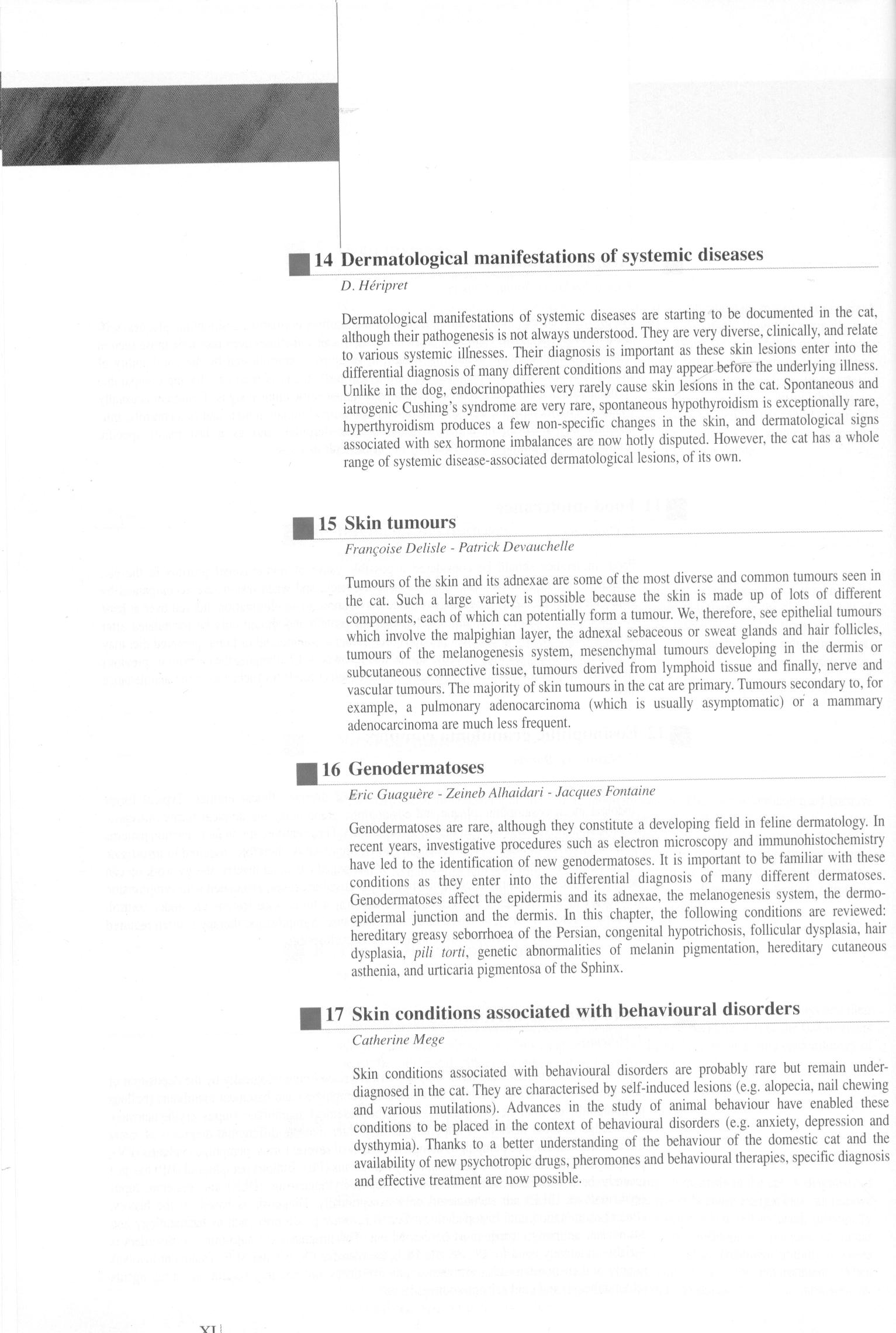5 (1170)

|14 Dermatological manifestations of systemie diseases
D. Heripret
Dermatological manifestations of systemie diseases are starting to be documented in the cat, although their pathogenesis is not always understood. They are very diverse, clinically, and relate to various systemie illnesses. Their diagnosis is important as these skin lesions enter into the differential diagnosis of many different conditions and may appear before the underlying illness. Unlike in the dog, endocrinopathies very rarely cause skin lesions in the cat. Spontaneous and iatrogenic Cushing’s syndrome are very rare, spontaneous hypothyroidism is exceptionally rare, hyperthyroidism produces a few non-specific changes in the skin, and dermatological signs associated with sex hormone imbalances are now hotly disputed. However, the cat has a whole rangę of systemie disease-associated dermatological lesions, of its own.
■ 15 Skin tumours
Franęoise Delisle - Patrick Devauchelle
Tumours of the skin and its adnexae are some of the most diverse and common tumours seen in the cat. Such a large variety is possible because the skin is madę up of lots of different components, each of which can potentially form a tumour. We, therefore, see epithelial tumours which involve the malpighian layer, the adnexal sebaceous or sweat glands and hair follicles, tumours of the melanogenesis system, mesenchymal tumours developing in the dermis or subcutaneous connective tissue, tumours derived from lymphoid tissue and finally, nerve and vascular tumours. The majority of skin tumours in the cat are primary. Tumours secondary to, for example, a pulmonary adenocarcinoma (which is usually asymptomatic) or a mammary adenocarcinoma are much less frequent.
| 16 Genodermatoses
Erie Guaguere - Zeineb Alhaidari - Jacąues Fcmtaine
Genodermatoses are rare, although they constitute a developing field in feline dermatology. In recent years, investigative procedures such as electron microscopy and immunohistochemistry have led to the identification of new genodermatoses. It is important to be familiar with these conditions as they enter into the differential diagnosis of many different dermatoses. Genodermatoses affect the epidermis and its adnexae, the melanogenesis system, the dermo-epidermal junction and the dermis. In this chapter, the following conditions are reviewed: hereditary greasy seborrhoea of the Persian, congenital hypotrichosis, follicular dysplasia, hair dysplasia, pili torti, genetic abnormalities of melanin pigmentation, hereditary cutaneous asthenia, and urticaria pigmentosa of the Sphinx.
■ 17 Skin conditions associated with behavioural disorders
Catherine Mege
Skin conditions associated with behavioural disorders are probably rare but remain under-diagnosed in the cat. They are characterised by self-induced lesions (e.g. alopecia, nail chewing and various mutilations). Advances in the study of animal behaviour have enabled these conditions to be placed in the context of behavioural disorders (e.g. anxiety, depression and dysthymia). Thanks to a better understanding of the behaviour of the domestic cat and the availability of new psychotropic drugs, pheromones and behavioural therapies, specific diagnosis and effective treatment are now possible.
Wyszukiwarka
Podobne podstrony:
22 (301) after check Figurę 5.14 Inlermcdiatc lcvcl of UPS pcrspeetive for Online Computer shopping
00152 ?cb17ca464b8901288e6dd4f0513e8d 153 Optimization and Sensitiyity Analysis Table 14. Cost Comp
...J Rys. 9.3-14. Układ kotew wzmacniających systemu Helifix u konstrukcji drewnianej wg
Dostępne: Wypożyczalnia, Czytelnia bl. 14 1. Analiza i ocena wykorzystania systemó
4?PRE-ALGEBRA: Quiz 8.2 - Answer Key 1. Which of the points (-2, 12), (-1, 12), (3, -10), and (-2, 1
14 6138a permin of copenhagen dsntsh art iweOawolc14-6138 i □ • 1 □ i Kartu ■ i w»««n • m ne tuatts
2 14 The success of the negotiation is the success of the preparation madę for it... A negotiator ha
644 UN DEBAT : LES MENTALITfiS COLLECTlVES 14 outstanding authors of the humanist generation.42
dsc00101 (14) Wrocław University of Fechnoiogy Ewolucja i generacje komputerów... Ewolucja...
Rodzinka Robinsonów kolorowanka (14) THE FUTURĘ OF HIP HOP
S 14 _to dhjgoterrńinovrt&ująca systematyczny wzrost, tub Obserwowanej w szeregu
46066 Uczciwek165 (3) [14] Mierzejewski L., Szeląg A., Gałuszewski M., System zasi
więcej podobnych podstron